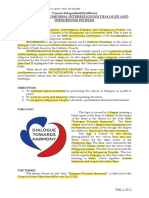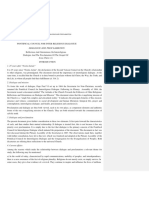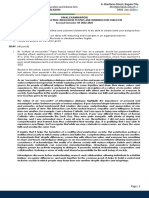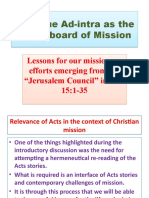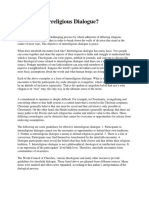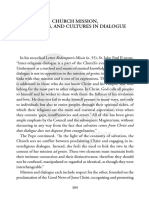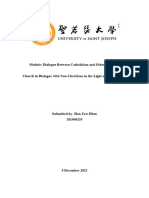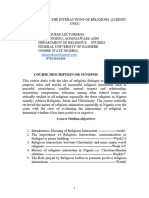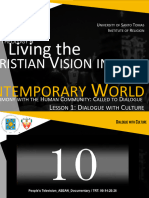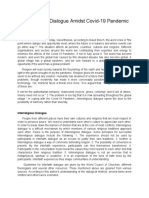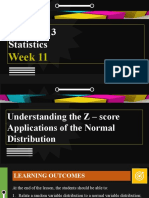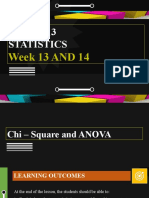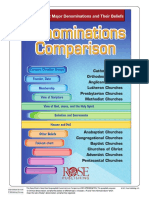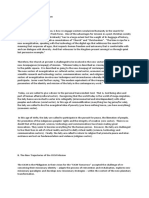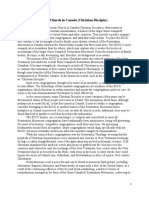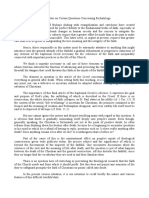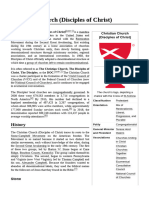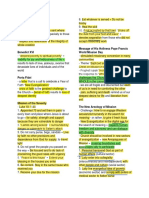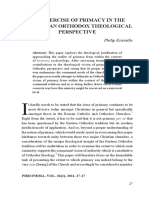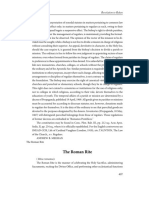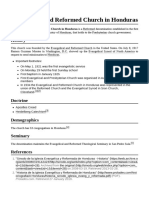CODE 187: CICM in Action A (Justice, Peace, Indigenous and Interrelig... https://usl-tuguegarao.neolms.com/student_lesson/show/1968512?lesson...
CODE 187: CICM in Action A (Justice, Peace, Indigenous and Interreligious Dialogue)
Final Learning Resources
Week 3
INTRODUCTION
Pope Francis as the head of the Catholic Church fosters a spirit of dialogue that is held important in the whole of Catholic Tradition. He promotes a dialogue based on the teachings and practices clearly
defined in the encyclical “Nostra Aetate” – “The Declaration on Nostra Aetate” – “The Declaration on the Relation of the Church to Non-Christian Religions” proclaimed by St. Pope Paul Vl in 1965.
METHOD/S OF FACILITATING INTERFAITH/RELIGIOUS DIALOGUE
Nostra Aetate (NA) is main document on other religions of Vatican II but it was seminal and not fully developed. Notra Aetate (NA) is the main Vatican II document on other religions. Two important themes of
Notra Aetate are:
1. The necessity of interreligious dialogue.
2. The discernment of the “rays of truth” in other religious traditions.
Nostra Aetate gives us three fundamental reasons why dialogue is essential in the life of the Church.
First is the conviction that We All belong to One Human Family – a principle widely shared by religions all over the world. Dialogue is imperative in understanding the various spiritual and faith traditions.
We must seek the common ground of shared values among diverse faiths to show that despite diversity we are one human family with the same fundamental aspirations for mutual respect, for acceptance and for
living in peace.
The second reason – We are all Gifted with a sense of Spirituality. Every human being has a spiritual sense, a sense of the divine – expressed in different ways according to different faith traditions. Even
Non-believers are gifted with this sense as evidenced by recent advances in neural and cognitive science which support the idea that the spiritual or the sacred is fundamental to human experience and flourishing.
Spirituality is the entry point of dialogue and through interreligious dialogue, we could share stories on how our experiences on divine love, our spirituality, promotes attitudes that move us to action towards the
attainment of shared values such as justice and lasting peace.
The third reason for Interreligious Dialogue is based on the universal principle that We have a Shared Responsibility for the Common Good. Pope Francis believes that our capacity to work together for
the common good can come only through compassion and mercy and the ability to empathize with one another, especially those who are in need. So, we ask ourselves, what have we done for the hungry and the
poor; for the refugees and those internally displaced by conflict? What have we done for peace in the World; for Mother Earth, our common home? We can see that there are plenty of activities where believers of
different faiths can work together towards common goals, promote a different way of life and make a positive change in this world.
Redemptoris Missio was issued by Pope John Paul II on December 7, 1990 on the occasion of the 25th anniversary of the Conciliar Decree AD GENTES.
Chapter Five of Redemptoris Missio; the Paths of Mission emphasized interreligious dialogue. It contains the following:
# 55 “Interreligious is part of the Church’s evangelizing mission.”
# 56 Dialogue does not originate from tactical concerns or self-interest, but is an activity with its own guiding principles, requirements and dignity. It is demanded by deep respect for everything that has been brought
about in human beings by the Spirit who blows where He wills. Through dialogue, the Church seeks to uncover the “seeds of the Word,” a “ray of that truth which enlightens all men”; there are found in individuals
and in the religious traditions of mankind. Dialogue is based on hope and love, and will bear fruit in the Spirit. Other religions constitute a positive challenge for the Church; they stimulate her both to discover and
acknowledge the signs of Christ’s presence and of the working of the Spirit, as well as to examine more deeply her own identity and to bear witness to the fullness of Revelation which she has received for the good
of all.”
# 56 A vast field lies open to dialogue, which can assume many forms and expressions: from exchanges between experts in religious traditions or official representatives of those traditions to cooperation for integral
development and the safeguarding of religious values; and from a sharing of their respective spiritual experiences to the so-called “dialogue of life,” through which believers of different religions bear witness before
each other in daily life to their own human and spiritual values, and help each other to live according to those values in order to build a more just and fraternal society.
REFLECTION OF THE TEXTS OF REDEMPTORIS MISSIO CITED ABOVE:
In our time, dialogue can be understood in many ways. At the purely human level, it is “reciprocal communication, leading to a common goal or, at a deeper level, to interpersonal
communion.” In the context of religious plurality, it means not only discussion, but also constructive relations with individuals and communities of other religions, which, in obedience to truth and
respect for freedom, are directed at mutual understanding. It includes “witness and the exploration of respective religious convictions”. With reference to the initiatives of the Catholic Church to
reach out to people of other religions, dialogue is also understood as “an attitude of respect and friendship” which permeates or should permeate all those activities constituting the mission of
evangelization in the world.
Interfaith dialogue describes exchanges among religious practitioners and communities on matters of doctrine and issues of mutual concern in culture and politics. Explore the engagement
of the world's religious traditions around theological questions and in their efforts to collaborate on questions of peace, human rights, and economic and social development.
UNDERSTANDING DIALOGUE
1. Dialogue does not mean giving up one’s religion or changing it.
Right from the start it is important to remember that when we come to dialogue the purpose is neither to give up our religion, to compromise nor to change it.
2. Dialogue aims at making our religion and culture intelligible to others.
The world of religions is replete with misunderstandings and prejudices perhaps more so today than earlier due to the speed with which news in the electronic media travels. Just think of the uproar in the
Muslim world on the comment of Pope Emeritus Benedict XVI in a speech he delivered two years ago where he quoted an ancient author. Dialogue can clear up misunderstandings and remove prejudices. Dialogue
promotes and deepens understanding between the religions. The goal is to understand other religions as they understand themselves. This step aims at facilitating communication between people of different faith-
traditions.
3. Information and Understanding of Culture and Religion
The core of the communication process in Inter-religious Dialogue is understanding the culture and religion. There is a great difference between information and understanding. I may know of the facts about
your religion but the real challenge is to understand your religion, your practices and your beliefs.
Difference between Understanding and Information:
Understanding is qualitatively different from information. The informational level is an important step on the road to understanding. That is why one must neither neglect nor underestimate the difference
between them. Whereas information is USEFUL because it is descriptive by nature, understanding is TRANSFORMATIVE. I may describe a Catholic because I was informed of their beliefs and practices. But my
understanding of them changes me as a person in the way I treat them and encounter them. It transforms me from within.
4. Pre-understanding and Understanding
Let us go back to the phenomenon of understanding. Understanding takes place – for all of us – as influenced by our own background or pre-conditioning/pre-orientation. This background is also called
cosmovision of our understanding. Cosmovision is etymologically defined as Cosmo which means universe and vision as the way we look; hence cosmovision can simply be "the way we look at the universe". Each
of us are influenced by our own cosmovision. This is the reason why each one of us understands the universe differently.
1 of 2 17/01/2021, 7:19 pm
�CODE 187: CICM in Action A (Justice, Peace, Indigenous and Interrelig... https://usl-tuguegarao.neolms.com/student_lesson/show/1968512?lesson...
Pre-conditioning is not an understanding prior to understanding as the suffix “pre” might erroneously suggest. Rather, pre-conditioning/ pre-orientation is shaped both by our CULTURAL COMMUNITY and
our PERSONAL HISTORY. The pre-conditioning of our culture and each one’s uniqueness shape our understanding of reality.
Our cosmovision affects our understanding about other’s culture, religions, beliefs, and traditions and because we have these cosmovision, it influences how we see ourselves, other people, the world and
even God. When one’s mind is closed in understanding the beliefs, religions, cultures of other people, then Dialogue becomes impossible to happen. Or if does happen, it will be useless and meaningless as it
defeats its purpose of communicating our experiences in order to create a common ground of understanding and eventually of living in this multi-faceted world.
5. Culture and Cosmovision
Culture is the most comprehensive influence on us. And a cosmovision, a concretization of culture, brings out the special character of a culture.
1. The special character of a culture:
There is a specific experience of reality and a corresponding understanding of truth. The specific experience of reality refers to a specific understanding of God, World and Man/Woman – what we have been
calling cosmovision. The specific understanding of truth is closely related to the specific experience of reality.
2. We know about our cosmovision indirectly only when we encounter another cosmovision.
A cosmovision cannot be known directly but only indirectly when we encounter another cosmovision. In the encounter some differences come to the fore. A dialogical encounter brings out the differences
between cosmovision regarding values and attitudes, rites and rituals, prayers and hymns, and music, art and literature, etc. For all of us our own cosmovision, our culture and religion make eminent sense; that is
the reason why they are always taken for granted but not so the cosmovision, culture and religion of the others. In the Middle Ages the Catholic Church with an ecclesiology of “Outside the Church there is no
salvation” went on rampage to baptize everyone with the “cosmovision” belief that unless people were baptized, they cannot go to heaven. Now, with the discovery of oil in the Middle East in the 70’s there is this
Islamic Global renewal. Like the Christendom of the Middle Ages the fulcrum of Islam in the Middle East asserted their Islamic faith as the ONLY WAY to be saved. They are operating in their own “cosmovision” as
we did before.
6. God’s Absolute Revelation and Man’s Relative Reception
This is as it should be. We are at home in our own culture as others at home in their cultures. We need to realize that we are limited human beings. In spite of the absolute nature of God’s revelation we
contingent beings can receive absolute revelation only relatively in our finite minds, hearts and brings.
7. Religion and Culture
This confirms the following: A belief is valid in the faith-world where it was born, not outside it. The experience of reality and truth is expressed in the language of its culture. Beliefs of a religion are all
expressed in the language of its culture. That is why the beliefs of one culture are not automatically intelligible to those of another culture.
8. The Dialogue of Religions and Cultures
It is here that we have to locate the nature and role of dialogue, especially the dialogue of religions and cultures. The following considerations could help to understand the process of dialogue better. A
culture’s perspective, though valid, always remains PARTIAL and LIMITED. That is the reason why we need to share with one another our experience of reality and the truth of our revelation. Given the differences
between our cultures it is necessary to become familiar with our neighbor’s culture.
It is an offering because it is ever extended not only in the pleasantness of appreciation but also in, and even beyond, the pain of rejection. Dialogue is an offering because it respects the antipathies of both
Muslim and Christians and the pace with which they strive to ease their hurts and to heal their wounds. Here dialogue is compassion.
Besides being an offering, dialogue is a CHALLENGE as well. It asks of a believer whether his faith does not require him to rise above his prejudices, even those that stem from real pain. It is a challenge to
scrutinize the pain-filled PAST yet HOPE still to start a chain of happy memories for tomorrow. Dialogue is above all a communion of people in total surrender to God, who persist in the hope that all can have a
change of heart.
REFERENCE:
Reynaldo O. Dumpayan, “The More, the Merrier: Ecclesial Pluralism and Fidelity to Tradition”, Saint Louis
University Research Journal, Vol. 38, no. 2, Baguio City: Saint Louis University Printing Press (December 2007).
Congregation of the Immaculate Heart of Mary, A Passion for Mission: 150 Years of CICM, (Manila: Cover & Pages Corporation, 2012).
John Hick and Paul Knitter, eds., The Myth of Christian Uniqueness, (Maryknoll: Orbis Books, 1987).
Lino Gregorio V. Redoblado, Ethical Politics and Marginality In Emmanuel Levinas, Hapag: A Journal of Interdisciplinary Theological Research, (St. Vincent School of Theology and Adamson
University) Vol. 6, No. 1-2 (2009).
Welte, Dal Nulla al Mistero Assoluto, (Marietti: Casale Monferrato, 1985).
John Paul II, Lay Members of Christs’s Faithful People, (Vatican: Libreria Ediitrice Vaticana, 1988).
CBCP Commission on Interreligious Dialogue, “After 50 years ... Vatican II’s Impact on the Local Church in the Philippines,” UST Theology Week, April 3, 2013.
Online:
Fr. Sebastian D’Ambra, PIME. “Peace-Work in the Tradition and Context of Islamic Communities” Living Flame – Spirituality of Peace Work, Volume 4 (2019).
Archbishop Gabriele Giordano Caccia. “Interreligious Dialogue: Path to Harmony” Address given by the Papal Nuncio at the Iran Embassy Manila Cultural Section, 15 October 2018.
Dominican Mission on Justice and Peace. Order of Preachers, www.op.org retrieved Feb. 5, 2019.
A Science of Spirituality for the 21st Century. Templeton Report 2015.
The Bishop-Ulama Conference. https://www.peaceinsight.org, retrieved Feb. 2, 2017.
Prof. Lilian J. Sison, Ph.D., is the Secretary General of Religions for Peace – Philippines and the Chair of the Asian Women of Faith Network. She is also the Director of the UST Office for International Relations and
Programshttp://www.ust.edu.ph/interreligious-dialogue-from-the-catholic-perspective/
Interreligious Dialogue from the Catholic Perspective. http://www.ust.edu.ph/interreligious-dialogue-from-the-catholic-perspective/
2 of 2 17/01/2021, 7:19 pm
